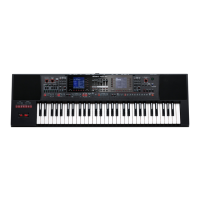5
An Overview of the E-A7
About the Memory
The state of the E-A7’s parameters and the data that you create are held in memory.
This memory is divided into three categories: “temporary memory,” “rewritable memory,” and “non-rewritable memory.”
Temporary memory (Temporary area)
A user program (UPG) that you load during a performance, and the panel settings that you modify while performing, are held in temporary memory
(the temporary area).
When you edit a User Tone or user drum kit, this data is also held in the temporary area during that time.
Settings in the temporary area are temporary, and will be lost when you turn o the power or recall other settings. If you want to keep the settings
that are in the temporary area, you must save them to rewritable memory.
Rewritable memory
Internal Storage
The memory that lets you store data inside the E-A7 is called Internal Storage.
This holds user programs sets (UPS), user styles, User Tone settings, and user drum kit settings.
External Storage
You can insert a USB ash drive and store data outside the E-A7. Such external memory (a USB ash drive) is called External Storage, and can be used
in the same way as internal storage.
External storage can also be used as an audio recording destination, or to back up data.
System Memory
System Memory is located inside the E-A7, and stores system settings that determine the overall operation of the E-A7.
User Sample Memory
This is memory that stores user samples that were captured by sampling or that were imported by the sample import function.
Non-rewritable memory
Preset Memory
This memory holds parameters for the internal sounds, internal styles, and Music Assistant. Its data cannot be rewritten.
Preset Wave Memory
This memory contains waveform data used by the internal sounds. Its data cannot be rewritten.
Eects
The E-A7 contains the following eects units. You can make settings independently for each of them.
MFX (Multi Eects)
This is a general-purpose multi-eect that modies the sound itself, potentially giving it a completely dierent tonal character.
A wide variety of types are provided, and you can choose the type that’s most appropriate for your purpose.
There are a total of three MFX units: one unit dedicated to the keyboard part, and two units for backing.
Chorus
Chorus is an eect that adds depth and spaciousness to the sound. You can choose whether to use this eect unit as chorus or as delay.
The depth of chorus can be adjusted individually for each part.
Reverb
Reverb is an eect that gives the sound a spatial ambience that’s characteristic of a performance in a hall.
Several types are provided, and you can choose the type that’s most appropriate for your purpose.
The depth of reverb can be adjusted individually for each part.
Input EFX
This unit can apply reverb or other eects to the sound from the input jacks.
Mastering Tools
The mastering tools consist of a mastering compressor and equalizer that are applied to all parts.

